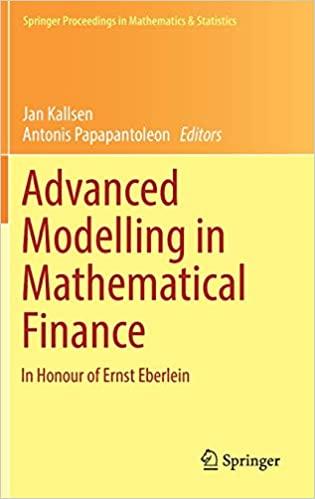Question
As the newly appointed financial analyst for Coverdale Office Machines Ltd., you have been asked to evaluate two alternative capital investment opportunities. The companys corporate
As the newly appointed financial analyst for Coverdale Office Machines Ltd., you have been asked to evaluate two alternative capital investment opportunities. The companys corporate income tax rate is 24%.
First, you must re-calculate the companys cost of capital. The company recently paid its annual dividend of $2.75 per common share. According to your calculations, the companys beta is 0.80. The companys common shares currently trade for $25.80 each on the TSX. The market return is estimated at 16% and the return on Government of Canada treasury bills is 3%. The company has 2.3 million common shares outstanding.
The company has preferred shares issued and outstanding that currently sell for $38.50 on the TSX. The preferred shares have a stated annual dividend of $2.31 per share. There are 900,000 preferred shares issued and outstanding.
Coverdale has a bond issue outstanding with nineteen years to maturity. The $30,000 face value bond offers a 5% semi-annual coupon. Bonds currently sell for 113.220% of face value. The bonds yield to maturity will be used as the estimated before tax cost of debt for the company. Coverdale has 1,900 of the bonds issued and outstanding.
The proposed project is to install robots in its Surrey facility. The companys senior management team has decided to purchase industrial robots in its manufacturing facility. The question is which robotic technology will the company be purchased.
Two alternative robots are being considered. Model 101 will cost $465,000. The alternative system, the T-1000 will cost $740,000. According to the Income Tax Act, robots are considered are CCA Class 10 assets with a CCA rate of 30%. As the decision is being made during the 2020 tax year, use the new PV of CCA tax shield formula throughout this project.
The Model 101 is an older technology. As a result, it has a 6-year useful lifecycle and an expected salvage value of $45,000. The T-1000 uses a newly developed technology, minetic poly alloy, which has a nine-year useful life span. The expected salvage value of the T-1000 is $83,000.
Both projects will require an additional working capital investment. For the Model 101 System, net working capital will increase by $15,000 at time zero and increase by further $3,000 per year over the life of the project. The systems net working capital investment will be fully recovered at the end of the last year of the systems useful life.
For the T-1000, net working capital will increase by $20,000 at time zero and increase by further $2,000 per year over the life of the project. The entire net working capital investment will be fully recovered at the end of the last year of the systems useful life.
As the company lacks the internal expertise to evaluate the feasibility of each system, Coverdale will hire an outside robotics consultant at the cost of $25,000. The consultant will help the management team decide whether the capital project is viable and, if so, the alternative that is most financially attractive. This analysis is needed before a decision can be made.
To recover project costs, the Engineering Department proposes to rent the new AI system to other businesses at the rate of $300 per computer hour. The older Model 101 has no excess productive capacity. The T-1000 has excess productive capacity of 100 hours per year. The companys policy allows the Engineering Department to rent the spare capacity of its equipment to outside companies.
If the new automation process is put into use, the pre-tax cost savings each year are estimated to be as follows. The estimated useful lifetime of the alternative systems are nine years.
Figure 1: Estimated Pre-Tax Cost Savings:
Year Model 101 T-1000 1 $125,000 $155,000 2 $125,000 $138,000 3 $114,000 $127,000 4 $103,000 $116,000 5 $99,000 $112,000 6 $95,000 $109,000 7 $101,000 8 $99,000 9 $83,000 As the financial analyst, you are required to draft a comprehensive memo, addressed to the Chief Operations Officer, answering the following questions:
1. What is the weighted average cost of capital for the company (e.g. the discount rate used for analyzing the budget proposals)?
2. How you would account for the $25,000 payment to the Consultant? Why? Be specific.
3. How you would account for the $200 per hour charged by the IT department? Why? Be specific.
4. Calculate the NPV of each alternative using the six steps of capital budgeting and the cost savings shown in Figure 1 above. Which alternative would you recommend? Be specific and provide an explanation for you answer.
5. The COO is concerned that new technology might make the AI system obsolete after five years. If this occurs and you only obtain five years of cost savings (as per Figure 1 above), which alternative (if any), would you now recommend? Assume that either system has zero salvage value at the end of their useful lives.
Step by Step Solution
There are 3 Steps involved in it
Step: 1

Get Instant Access to Expert-Tailored Solutions
See step-by-step solutions with expert insights and AI powered tools for academic success
Step: 2

Step: 3

Ace Your Homework with AI
Get the answers you need in no time with our AI-driven, step-by-step assistance
Get Started


